Hughes multi-modem prototype selected by DoD
Hughes Network Systems, LLC (HUGHES) has been awarded a follow-on contract to continue the second phase of a pilot study program to assess the feasibility of interoperability across multiple satellite communication (SATCOM) systems for the Department of Defense (DoD).

Under this award, Hughes will be responsible for prototyping a Flexible Modem Interface (FMI) for military terminals that will enable various military and commercial systems and services to interoperate in the field.
The new study — the second over the course of several years — builds on the growing commercial partnership with the DoD to assess what the ideal military SATCOM architecture would look like and how diverse systems could work together.
The assessment and prototype deliverables have the potential to create a more resilient, cost-effective, and flexible SATCOM architecture for DoD.
In Phase 2, Hughes will build on their recommendations from the first study and explore how an interoperable system solution could be effectively implemented by developing and producing the new FMI for demonstration and evaluation.
In 2017, Hughes participated in two different studies within the first phase of this project. In that first phase, Hughes recommended that the Defense Department pursue a SATCOM strategy that supports interoperability for wideband government applications, which would significantly enhance DoD’s communications infrastructure and reduce acquisition and operations costs.
Dr. Rajeev Gopal, Senior Technical Director, Advanced Systems for Hughes says in Phase Two of this program, Hughes is being asked to develop, demonstrate and deliver a hardware and architecture prototype solution to support interoperable SATCOM capabilities for the military, which will help fortify satellite communications in contested environments.
The delivered solution will increase the resiliency and interoperability of various commercial and military SATCOM systems and services used by the DoD, including over High- Throughput Satellites (HTS).
As part of the overall assessment, Hughes will be evaluating the needs and capabilities that DoD will require in the future, including a secure and affordable wideband communications architecture (WCA) that can facilitate varied and redundant space and ground transports.
The FMI prototype will be demonstrated within the context of a mission management architecture that supports wide-beam, spot-beam, and on-board processing satellites, including new GEO HTS and Low Earth Orbit (LEO) satellite constellations.
Rick Lober, vice president and general manager of defense and intelligence systems at Hughes added that the overall goal for Hughes is to help the Defense Department produce a solution that expands the capabilities of the U.S. government’s satellite communications.
To do that, Rick said, they will examine how to create an interoperable system that is flexible and resilient, allowing DoD’s various global applications to operate over its own satellite network as well as leveraging commercial satellites, management systems, gateways, waveforms, and modems for DoD terminals to increase mission assurance.
www.hughes.com
iDirect Government unveils a new, ruggedized satellite router
Direct Government (iDirectGov) has unveiled their 9050 OM ruggedized satellite router — the 9050 OM features enhanced security, military environmental standards and improved functionality in a ruggedized form factor for operation in harsh outdoor environments.
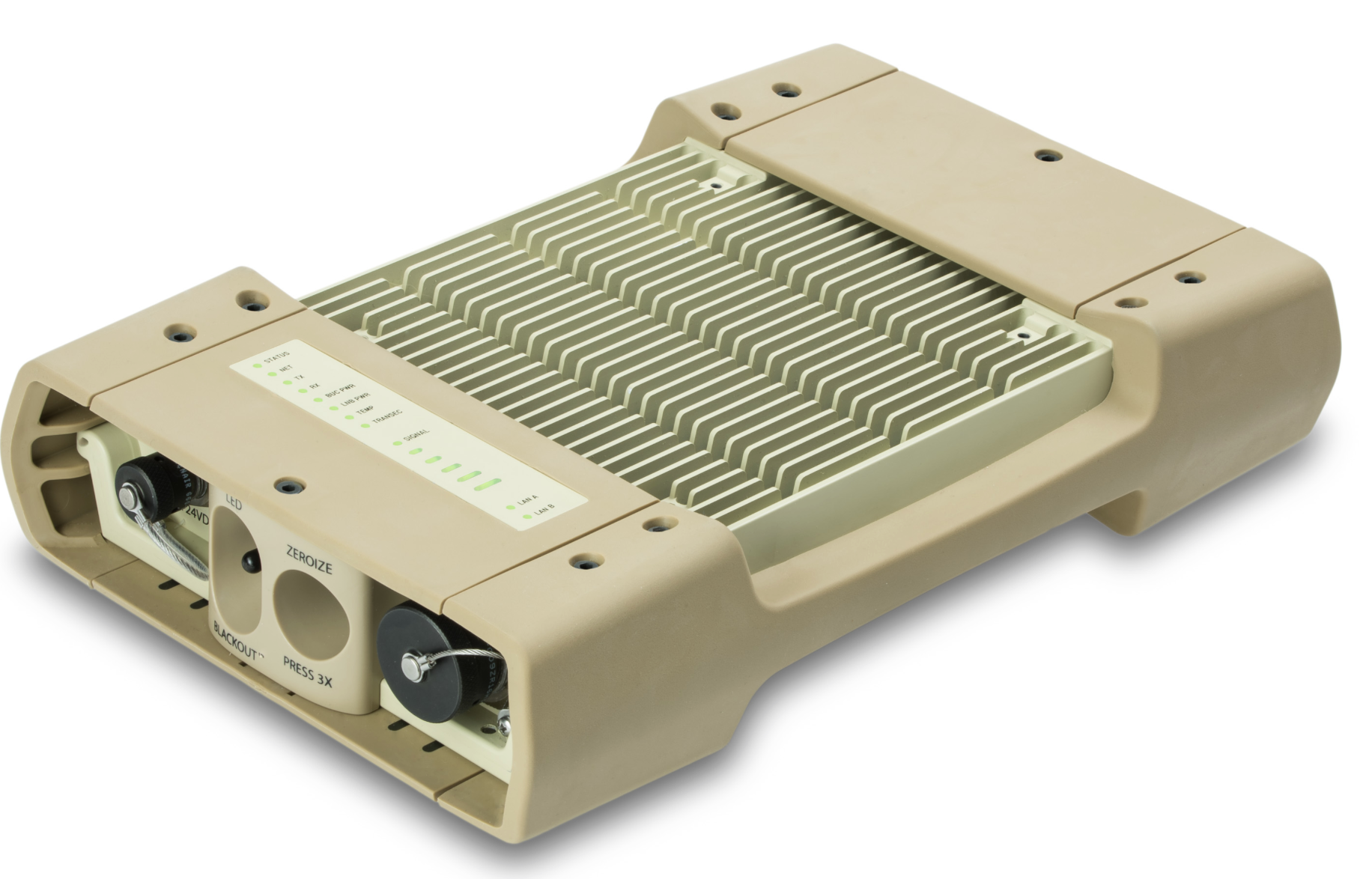
A 950mp integrated satellite router board resides at the heart of the 9050 OM, which protects the board from the elements including blowing rain or dusty conditions. Powered by Evolution® 4.2 software, the 9050 OM can operate in harsh environments in temperatures ranging from -40 degrees F to +131 degrees F.
While en route to a mission, the 9050 OM can survive a parachute jump from 25,000 feet or be submerged in water, and still be able to operate once it reaches its final destination.
The 9050 OM features are as follow:
• Transmit Key Line, to lower battery consumption and extend the mission as needed
• Blackout switch to turn off all LEDs for discrete operations
• Single data connector to support two LAN ports, console, GPS input, and Transmit Key Line
• Antenna pointing meter to ensure the satellite terminal is properly peaked
• Passively cooled – no powered fans required to cool down the product while in operation
• External power supply designed for outdoor use along with the product
• Federal Information Processing Standards (FIPS) 140-2 Level 3 certified
• Wideband Global SATCOM (WGS) certification ready
John Ratigan, President of iDirect Government, said this is going to drastically change the way operators work in the field. Gone are the days of lugging around heavy transit cases in inclement weather and remote locations — this 9050 OM is durable, compact and powerful, enabling iDirectGov’s 950mp satellite router board to send critical information over the airwaves without overheating or experiencing a failure in the field. The company’s engineers designed and tested this solution so that the men and women who defend our nation can communicate seamlessly in order to complete their mission and keep us safe.
www.idirectgov.com
U.S. military cyber ops students “Game On...”
Two students at the Naval Postgraduate School here have created a way to bridge a training gap in U.S. military cyber operations — through a game.
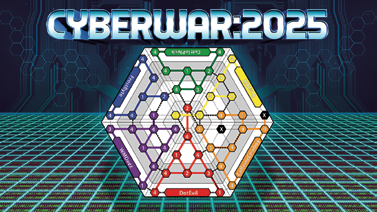
For their master’s thesis, Army Master Sgt. David Long and Army Capt. Chris Mulch designed and developed CyberWar 2025, a computer-based strategy war game that challenges players to navigate through the core concepts of the cyber realm.
“The goal of CyberWar: 2025 is to stimulate and increase players’ knowledge and experience of cyberspace operations,” Mulch said. “The basic idea is to learn as you play.”
In approximately 30 to 60 minutes of turn-based, ‘sandbox’ gameplay, players employ a range of the basic concepts laid out in Joint Publications 3-12(R) Cyberspace Operations. A deft combination of offensive cyber operations, defensive cyber operations and computer network exploitation can lead a player to victory, even if in a relatively weak position.
“Everybody starts out on a level playing field,” Mulch explained. “Players utilize resources in a way they see fit, whether those resources are put into offense, defense or reconnaissance.”
A sense of urgency has burgeoned in the United States over the last decade as adversaries — state and non-state actors alike — have increasingly turned to the cyber domain to actively work against U.S. national security interests.
In a recent speech at John Hopkins University, Defense Secretary James N. Mattis reiterated that the Defense Department absolutely must “invest in cyber defense, resilience, and the continued integration of cyber capabilities into the full spectrum of military operations. Our competitive edge has eroded in every domain of warfare — air, land, sea, space, and cyberspace — and it is continually eroding.”
President Donald J. Trump echoed this in his fiscal year 2019 budget request to Congress, calling for a 4.2 percent increase in the Pentagon’s cyber funding to US$8.5 billion as U.S. Cyber Command approaches full operational capability as a newly-unified combatant command.
“What’s going on in cyber policy is a big question right now in DoD,” Mulch said. “What does our competitive balance look like? Should we be strong? Should we be putting time and resources into defense, reconnaissance or research?”
Yet, there remains a critical gap in how DoD goes about preparing the military to engage in this domain. Several educational courses and training exercises have been developed to prepare leaders to plan and execute cyberspace-based effects to support operations, but there are no virtual simulations used by the military to train and educate service members in the basic concepts of cyberspace operations.
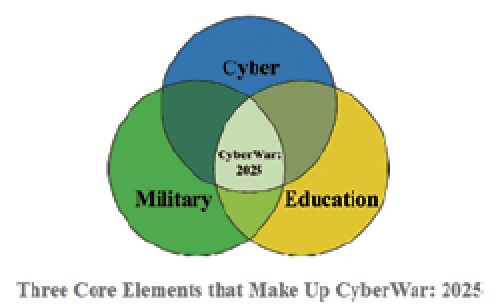
Filling a Gap
When Long, a cyberwarfare practitioner at Fort Meade, Maryland, and Mulch, an information operations officer, arrived at the Naval Postgraduate School in June 2016 to begin their graduate work in information strategy and political warfare, it didn’t take them long to turn to solving this.
“People would say I’m the cyber guy, even though I really don’t like that term,” Long said. “When I came to NPS, my promise to myself was to [impact] the Army cyber mission; I had a lot of ideas about how we can educate people about cyber operations, and how we could do it correctly.”
Attending a game theory course, they encountered an article exploring the strengths and weaknesses of American cyber capabilities vis-a-vis Russia and China. Over spirited arguments over how much emphasis the U.S. should be placing on offense, defense or reconnaissance, the kernel of CyberWar: 2025 was formed.
“We used game theory to explore that, but that was the basis of ‘hey, I think we have a question here that we could look into,’” Mulch said.
Army War-Gaming
Coming up with a game was not too far of a stretch: the U.S. military has a long history of using games to prepare, understand and even plan for war. The earliest use of war gaming in the U.S. dates back to 1883, when Maj. William R. Livermore used topographical maps to practice the art of war. Livermore’s work was itself based on Kriegsspiel, a tabletop game the Prussian military had used since 1812 to train their officers.
However, such gaming is not just “beer and pretzels,” Long stressed. Serious games, which academic literature refers to as “gamification”, are played to stimulate creative thinking, decision making and problem solving to learn. Good gamification allows players to synthesize new knowledge and make critical judgments.
“With CyberWar: 2025, what we’re really looking at, other than reinforcing terminology, is letting people learn through discovery what the relationship between cyber effects is,” Mulch said.
For example, if a player has developed strong defensive capabilities but weak offensive capabilities, what would a potential conflict look like with an adversary with strong offensive capabilities?
“In a nutshell, that’s what CyberWar: 2025 provides: An interactive experience for you to reinforce concepts and potentially look at other ways to solve a problem,” Mulch said.
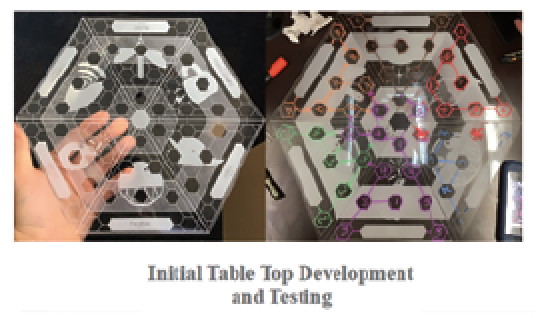
Game Play
The game, he said, is intended to feel like Diplomacy, a classic 1954 strategy board game that relies as much on player interaction as moving pieces around a board.
At the start of CyberWar: 2025, six players are randomized for anonymity, so you could be sitting next to somebody, but not necessarily be located next to them on the board.
Play then proceeds simultaneously by round, with each player submitting their orders, which are resolved all at once before the next round.
“The players communicate with each other and maneuver around the map, which consists of 48 interconnected ‘server nodes’ that are represented by hexagons,” Mulch explained.
As players capture new server nodes, they gain points which they then use to either conduct an action or research three tiers of new, more advanced effects for these actions.
“The more points you have, the more you can put into effects, and then you can use these to launch attacks against your adversaries and so forth,” Mulch said.
The game play is simple and intuitive, but there’s a lot going on under the hood.
When all players have submitted their orders, the software engine running the game sorts their input, calculates each of their actions, analyzes the results and then broadcasts these back to the players within a split second.
Training Applications
“What we accomplished over a tight nine-month time frame was to effectively pack ten pounds of product into a five-pound product bag,” Long said. “You learn by making mistakes: you can explore multiple paths and if you make a mistake, that doesn’t mean you lose the game.”
From inception, Long and Mulch designed the game to be applicable for all branches of DoD and their subordinate cyber fields, as well as an educational tool for decision makers and leaders on cyber policy.
As their thesis was published in December, CyberWar: 2025 has been successfully adopted in cyber courses at NPS, though Long and Mulch would like to see it become more widely available.
“The way forward is to have it incorporated into cyber education courses across the services,” Mulch said.
The simulation also has great potential as refresher training, the duo said. For service members who’ve already received cyber training, yet haven’t practiced it for some time, CyberWar: 2025 serves as an efficient tool to get them back up to speed prior to deployment or a training event.
“Whether they’re about to go out to the National Training Center at Fort Irwin, California, the Joint Readiness Training Center at Fort Polk, Louisiana, or anywhere else, CyberWar: 2025 could be implemented as a reinforcement tool at the home station pre train-up before they go into an actual exercise,” Long said.
CyberWar: 2025 has been effectively used in the classroom at NPS, but the students hope to soon see the application available to a broader DoD audience. With further development, incorporating computer-controlled players, Long and Mulch see the opportunity for a DoD-wide training tool.
Commands and NPS students interested in this project should contact:
SFC David “Ty” Long, Student, Department of Defense Analysis, GSOIS
CPT Chris Mulch, Student, Department of Defense Analysis, GSOIS
Dr. Michael Freeman, Associate Professor, Department of Defense Analysis, GSOIS
Dr. Robert Burks, Associate Professor, Department of Defense Analysis, GSOIS
GSOIS = Graduate School of Operations and Information Science at the Naval Postgraduate School, Monterey, California
https://www.nps.edu/web/gsois/
A boost for soldier communications
The days of simple radio communication seem to be over for the soldiers of the 173rd Airborne Brigade Combat Team.
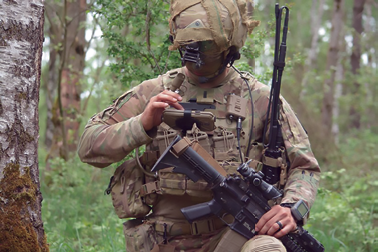
U.S. Army 1st. Lt. Michael Austin, a platoon leader for Attack Co., 1st Battalion, 503rd Infantry Regiment, uses an end-user device to report information to his company commander through the Integrated Tactical Network during a live-fire exercise in Grafenwoehr, Germany. Army photo by Spc. Joshua Cofield.
In the place of radios comes a sophisticated yet intuitive communication system that allows leaders at the squad level and higher to rapidly share information across the military network. This new platform, called the Integrated Tactical Network, revolutionizes the way tactical leaders are able to communicate, improving the lethality of small units, while at the same time increasing safety and situational awareness for soldiers.
“Besides each of us having access to the mission graphics, we will be able to battle track each other,” said Army 1st. Lieutenant Michael Austin, a platoon leader in Attack Company, 1st Battalion, 503rd Infantry Regiment. “If we’re in a movement to contact and we take chance contact, we can use this to very accurately shift fires, and have more fires on the enemy while being very safe because we know our exact front-line trace.”
The benefits for soldiers in the field are extensive. With the platform, leaders are able to track the positions of the units all around the battlefield, as well as share text messages, voice communication and even pictures.
Crystal-Clear Communications
The equipment was fielded to the battalion two days prior to executing company-level combined arms live-fire exercises in Germany that were conducted from May 1 to 5. After a one-day class, the radio telephone operators and the platoon leaders understood the process for using the devices and were able to use them for the actual exercise.
“We had crystal-clear communications the entire time and that’s the first time we’ve had that,” Austin said. “Our scouts were able to take photos directly from their hide site, so we had eyes on the objective in real-time.”
The new system uses equipment that soldiers are already familiar with, including the multi-band, inter/intra team radio to project data as well as a modern smartphone for the actual interface.
“This system is simple to field and use,” said Army Capt. Michael Belina, the signals officer for 1st Battalion, 503rd Infantry Regiment. “We were able to learn it at the [operator] level in one day. The software is really intuitive since most soldiers know how to use smart phones as a second nature, [so] there’s no issue with them picking up the features and figuring it out.”
Platoon leaders, fire support officers and company commanders have the devices now, but squad leaders will have the same devices soon.
“When the platform is fully implemented, paratroopers will have an additional quality radio and access to the same common operating picture as their leadership,” Belina said. “The common soldier will have a better idea of what’s going on around him, and it will basically cut out some of the talk that is required to build that picture. It will be more immediate.”
Another benefit of the new equipment is that it simplifies the communications package for the soldier on the ground.
“It makes it so you don’t have to have a truck with a [Joint Capabilities Release] on it, with a vehicle and power to it. It takes away all that equipment and simplifies it,” said Army Sgt. Alex Jones, a retransmission team noncommissioned officer with the 1st Battalion, 503rd Infantry Regiment’s communications section.
On a less tangible level, this system empowers junior leaders to know their mission and react quickly as the situation on the ground changes.
“As an airborne unit, we already do a good job of going down to the lowest level to ensure everyone knows the plan,” Austin said. “But it’s typically just the platoon leaders and platoon sergeants and up that have the finer details. This ensures even lower levels know the plan.”
By improving communication across the formation, empowering junior leaders and ensuring soldier lethality on the battlefield, this new system shows just how the 173rd Airborne Brigade Combat Team soldiers continue to lead the force not just as fighters but also as modern, adaptable communicators on today’s battlefield.
Story by U.S. Army Major Chris Bradley, 173rd Airborne Brigade Combat Team
Preparing warfighters today for the future...
On the far southwest end of Schriever Air Force Base is an operations warehouse known as ‘the Barn,’ where members replicate live GPS and satellite communication electronic attacks for training service members across the world.
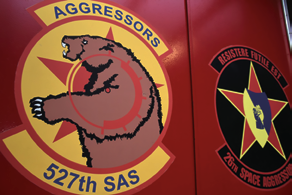
This is the home of the 527th Space Aggressor Squadron which relies on its total force integration to get the mission done, which includes 26th Space Aggressor Squadron Reserve personnel. The 527th SAS stood up as the first space aggressor unit in 2000, while the 26th SAS activated in 2003. The history of the space aggressors traces back to the Vietnam War, when they were established to address aircrew training deficiencies.
“During that time, there were unsatisfactory kill rates in the air domain,” said Capt. Brian Goodman, training flight commander, 527th SAS. “Adversaries were shooting down too many aircraft, especially compared to past successes. They realized they were executing so poorly in air-to-air combat because pilots were not exposed to adversaries’ techniques and capabilities.”
Thus, the evolution of the air aggressors. As the U.S. Air Force’s mission portfolio grew, the aggressor program grew toward space, which is now known as the space aggressors.
“We narrow our mission down to ‘know, teach, replicate,” said Maj. Sheri Lattemore, a Canadian service member and director of operations, 527th SAS. “We know and understand all the realistic and relevant threats and we teach those threats to different training audiences.”
“The 527th SAS has three mission sets which involve GPS electronic attack, satellite communications electronic attack and orbital engagement systems,” she added. “GPS electronic attack is when we put noise over the GPS signal so nobody can receive the signal on their receivers. We do the same thing for satellite communications; however, we will send our signal to the satellite itself so communication on the satellite is no longer possible. For orbital engagement systems, we play the role of the adversary against satellites.”
These tactics are engaged as part of military training exercises isolated to controlled environments. At no time do aggressors use these tactics outside of coordinated and approved exercises.
To best prepare for the challenges they may face, the aggressors have an intelligence flight whose entire function is to research adversaries’ capabilities, weapons systems, limitations and how they’re going to employ those systems. The flight coordinates with the intelligence community to gather information.
The 527th SAS then conducts the teaching and replication part of their mission with the warfighters, including the Air Force, sister services, allies and coalition partners.
“In the summer of 2016, we created a memorandum of agreement with the U.S. Army, then followed by the U.S. Navy,” Lattemore said. “We train them to do our mission, with the intent of creating their own aggressor units.
“We plan to have Canadians visit us to absorb as much information as they possibly can start their own GPS electronic attack unit,” she added. “Over the years I have been here, I’ve learned a lot about the policies and procedures, but also how to create an aggressor unit. We want to show them they can provide this training in Canada too.”
On a year-round basis, the squadron participates in various exercises. The 527th SAS gathers intelligence and provides relevant and realistic training for the warfighters that helps enhance their situational awareness regarding adversary space systems. The space aggressors also participate in RED FLAG at Nellis Air Force Base, Nevada.
During those exercises, the 527th SAS conducts adversarial tactics including jamming satellite communications and GPS receivers in an attempt to teach warfighters the effects of the adversaries’ weapon systems. The friendly forces then attempt to identify and mitigate the problems associated with these effects.
“For exercises, we work closely with the 26th SAS,” Lattemore said. “We support three RED FLAGS a year as well as weapons school integration, which is twice a year.”
According to Capt. Nathaniel Lee, assistant to the flight commander for aggressor weapons and tactics, 527th SAS, the squadron is developing a threat replication program from the ground up, to be finalized this April. He explained the need for space aggressors is increasing because adversaries are always developing new capabilities. Lee reflected on what it means to be a part of the squadron.
“We hear a lot in Air Force Space Command about the looming threat of combat in space,” he said. “Understanding the threats and developing tactics are centered on the aggressors. Knowing the space community is getting that out of this small organization is something we take a lot of pride in.”
Story and photo by Senior Airman Arielle Vasquez, 50th Space Wing Public Affairs. U.S.A.F.


